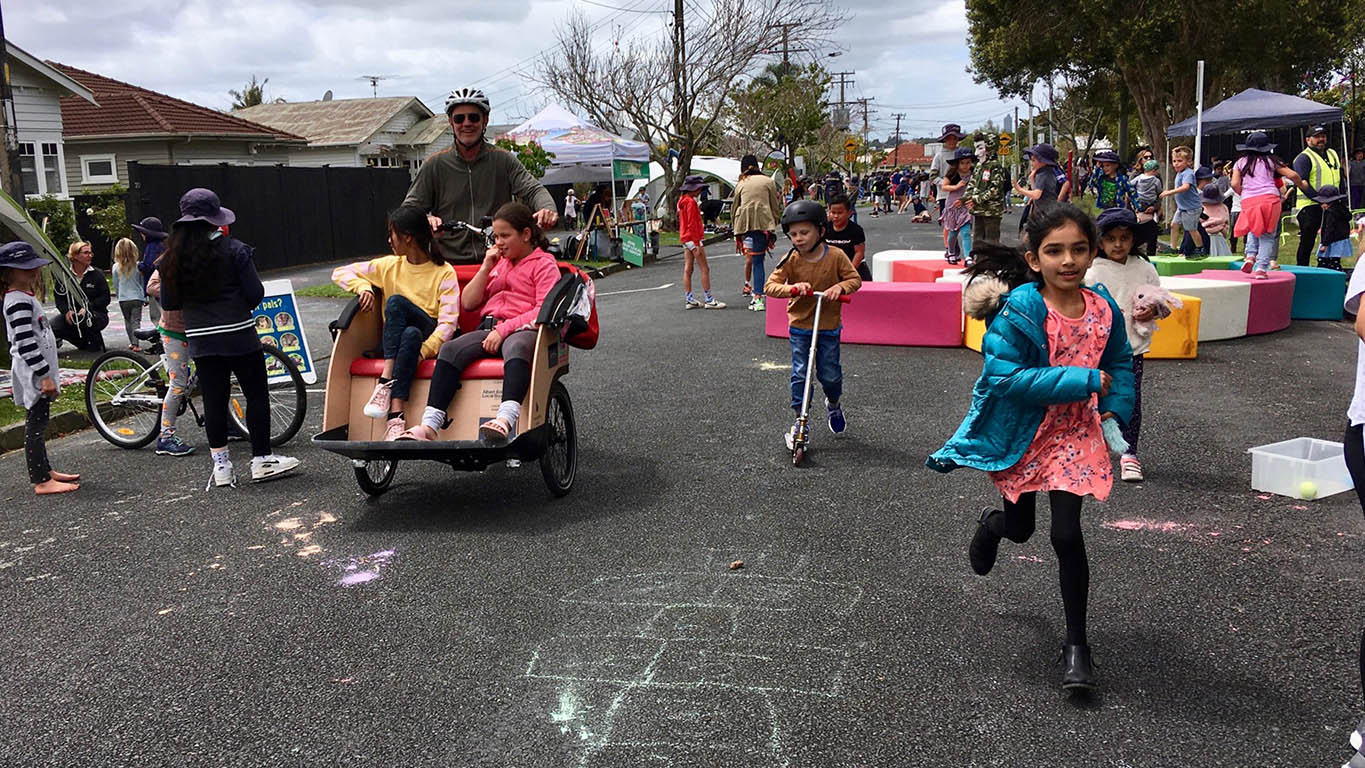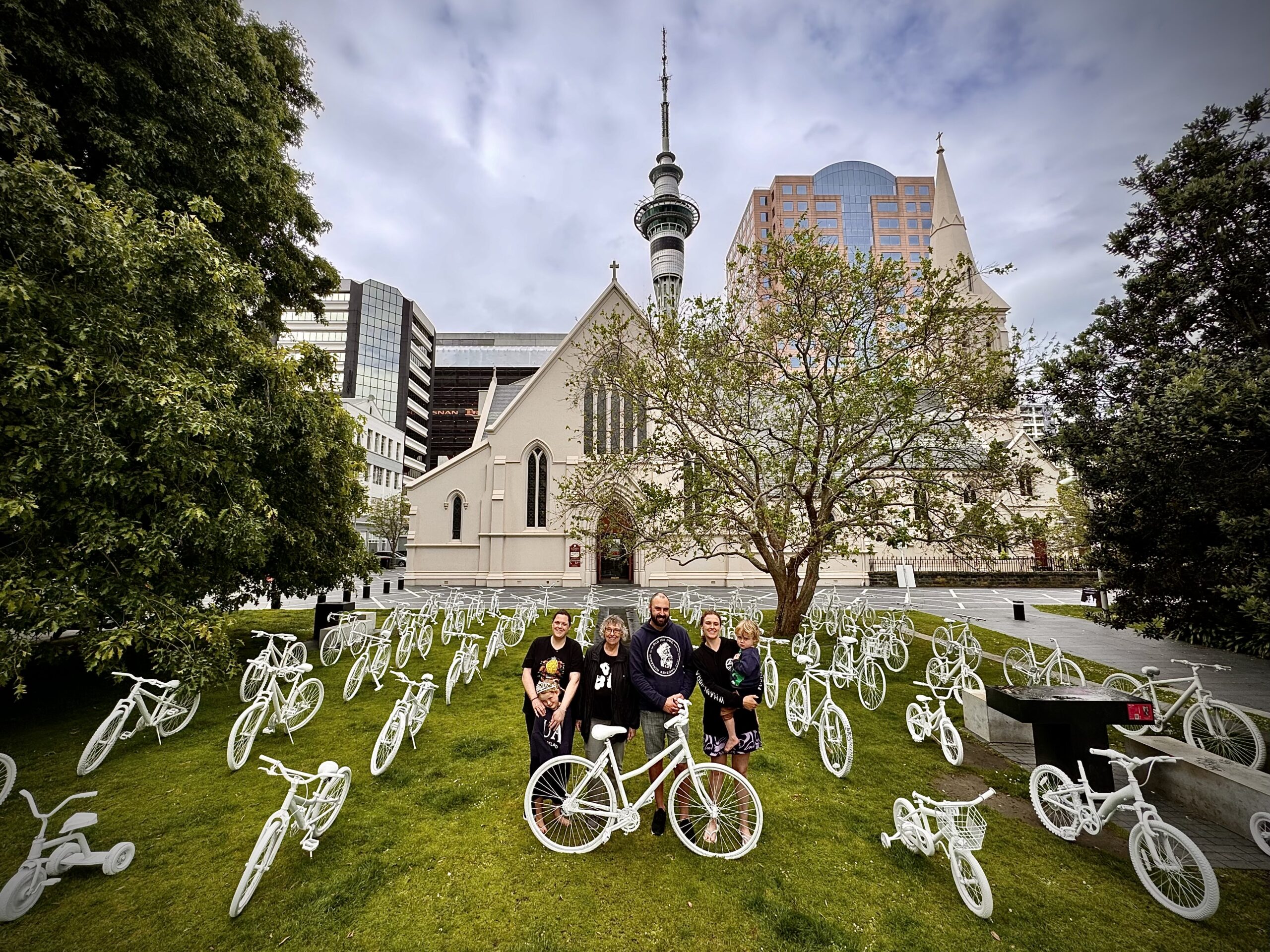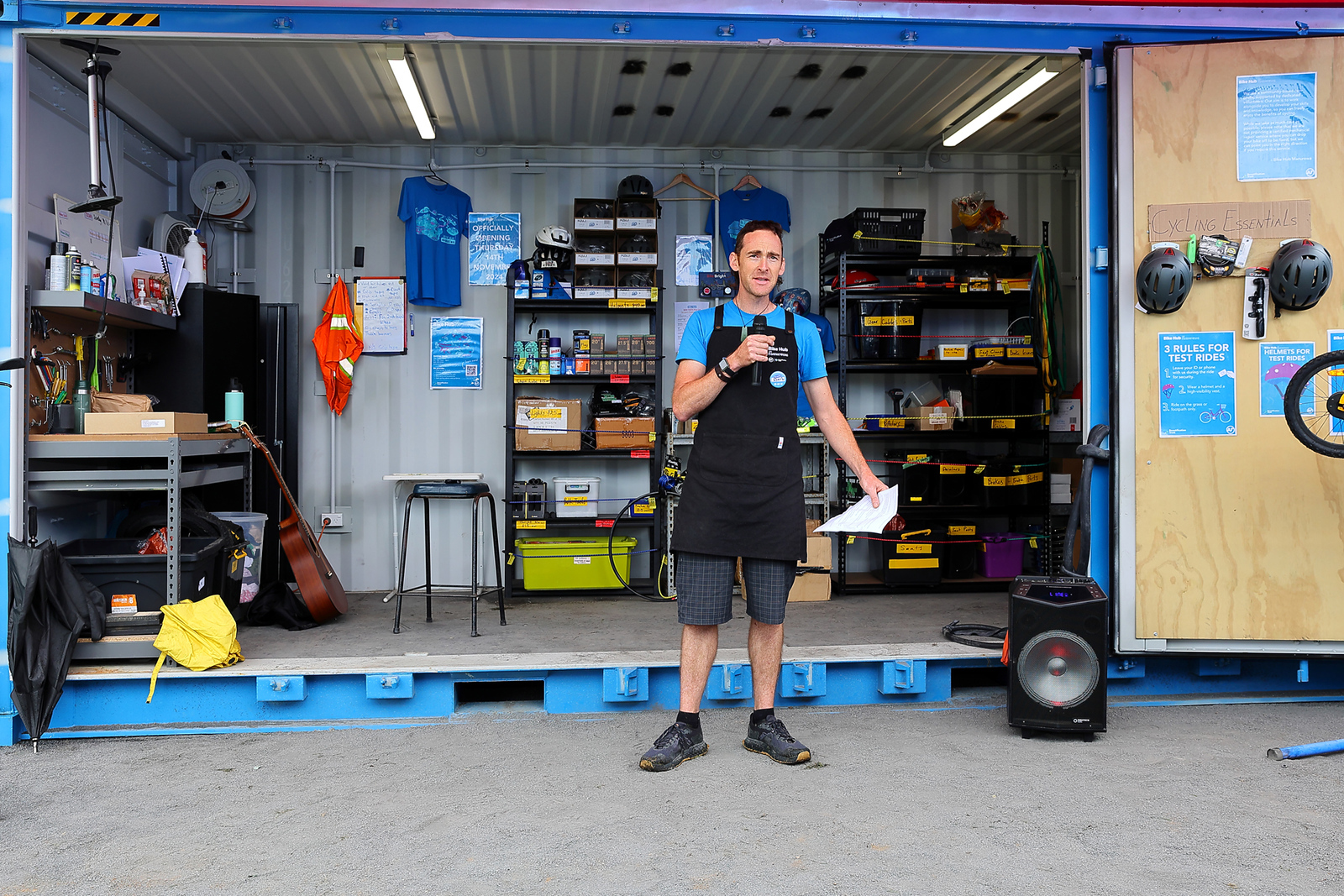Our recent post on the potential threat to the three Inner West projects noted it’s been a long road for Auckland Transport to get to this point of imminent delivery.
We know, because we were there all the way.
One of Bike Auckland’s most valuable contributions to our community, over more than two decades as the voice for people on bikes in Tāmaki Makaurau, is continuity.
We were there, back at the inception of a citywide bike network, advancing the vision when it was just a twinkle in a few bold eyes. We were there to ensure the vision grew in support – and gained crucial funding. We were there to encourage our transport agencies to rise to the opportunity.
We’ve been there alongside the transport agencies, volunteering hours of expertise to advise them on best practice in planning and designing networks, pushing them to build for success. The results might sometimes be mixed – we’re not in charge of outcomes – but we’ve never stopped expecting the best.
We’ve shared your stories over the years, to show the immense diversity, enthusiasm, demand and sheer potential for everyday cycling by all kinds of Aucklanders. We’ve empowered you to connect and take action at the local level, to grow confidence for cycling in your neighbourhoods, and to raise your voices for the safe streets and vital connections we all deserve.
We will continue to be there for you and with you, getting long-promised, long overdue projects over the line. And we’re setting our sights on how Tāmaki Makaurau can urgently and affordably deliver the full bike network this region needs – safer, smarter, and sooner.
All the while, we’ve kept the flame of community alive while building relationships with everyone in this business of building bike-friendly cities. We’ve also kept receipts.
Here’s a Bike Auckland timeline of these three projects, so you can see how and why they’ve come to be, and why it’s important to get them over the line at last, so we can all get on with the rest.
The 2010s
As we roll into this fourth (!) year of the 2020s, an absolutely critical decade for climate action, it’s worth a quick flashback to the 2010s, when vision and planning finally met political will and funding.
In 2012, the Auckland Plan included the promise of a citywide Auckland Cycle Network (ACN), to be fully delivered by 2026, and 70% completed by 2020. Gotta have goals, right?
By 2014, Council was aspiring to spend $30m per year to make it happen, and proposed boosting that even further to $55m a year to ensure the ACN could be finished by 2030, and 70% complete by 2024.
2015 brought a game-changer: the Urban Cycleways Fund. Riding on the success of Nga Haerenga/ the NZ Cycle Trail, the National Government proposed to match Council funding two-for-one with Crown funds and the National Land Transport Fund, to kickstart world-class cycling infrastructure in NZ cities.
Auckland pitched an ambitious ~$89m programme of protected fit-for-purpose bike routes, to be built in a staged rollout from 2015-2018, from the city centre outwards and around key local hubs.
Crucially, this signalled a great leap forward for bikeable neighbourhoods to complement the expanding network of longer-distance routes.
During this time, Waka Kotahi (NZTA) was forging ahead with paths alongside (and over, and under, and on top of) motorways, building on the success of the Northwestern Cycleway. Meanwhile, Auckland Transport would be responsible for creating safe local connections to where we live, work, shop, study and play, putting everyday cycling within reach of Aucklanders of all ages.
2016 saw AT consulting on a bike network for the Inner West, which would put 17,000 households within a 5 minute (or less) ride of safe arterial cycling routes. Perhaps due to proximity to town, and to the NW cycleway, this area already had a relatively strong appetite for cycling – knocking on a 4% bike-to-work mode share in some census blocks.
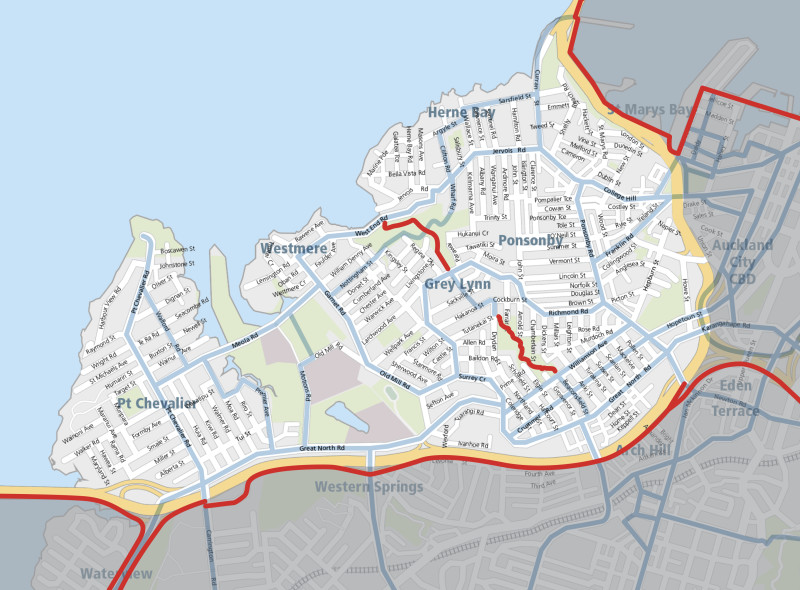
Public feedback strongly supported dedicated cycleways on main roads through the area. (There was also strong support for Ponsonby Road, which AT said deserved a “more holistic treatment” – we’re still watching this space!)
A revised network map was then drawn up, with the beginnings of an inner west network – the red routes. These were staged and designed as three separate projects for delivery by 2018.
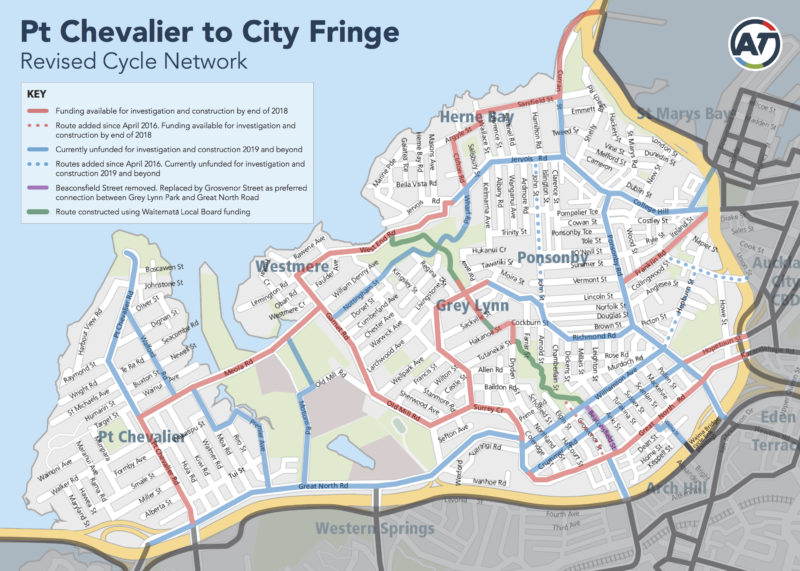
GREAT NORTH ROAD
Plans for Great North Road (along the ridge) had already been on the radar in 2014, and funding was secured through the Urban Cycleways Fund in 2015.
In September 2016, an initial design was consulted on. It took a basic approach, using concrete buffers to create protected bike lanes without moving the kerbs. As we said at the time, “fast is good, if the result is good.” Feedback was overwhelmingly supportive, with 86% of submissions in favour.
In 2017, AT consulted on a design for the GNR/ Bond St/ Grosvenor St intersection, but this didn’t proceed to construction.
The 2018 UCF deadline came and went. This project and others entered a second 3-year funding phase.
At the end of 2018, AT restructured its cycling team out of existence, and this project fell under the wing of the Connected Communities corridor improvements programme (while retaining its cycling funding).
As time ticked by without visible progress, safety on this stretch of Great North Road became a growing concern. As we reported in 2019, this was creating dangers for people cycling the ridge route, and for children and families trying to get Newton Central School.
Then, in 2021 – after the great pandemic pause – AT refreshed engagement with the public and stakeholders along the route, seeking final input on a quality design, with substantial improvements for pedestrian safety and bus convenience, more trees, and a planned construction date of 2022.
The largest group to give public feedback in the recent consultation? People who drive. The most strongly supported features? Safe cycleways, pedestrian safety, and bus improvements. People get it. And, as we wrote at the time, the bike paths would be “more permanent and better looking – so at least there’s that consolation prize for the delay.”
In September 2022, AT released this video outlining the work and the benefits to come. In late October 2022, early works commenced.
Six years after a design was first presented to the public, will the main works proceed as planned?
WESTMERE TO GREY LYNN
October 2016 saw the first consultation on a design for a route through Westmere and Grey Lynn, running along Surrey Crescent, Old Mill Road, and Garnet Road. It was part of a wider suite of plans that included Richmond Road through West Lynn shops, and a greenway via reserves and Grey Lynn Park.
We wrote at the time that this was the longest and perhaps most interesting of the routes, linking two primary schools, with local shops and intensification in the mix, and wide roads to work with. AT offered options, all of which involved some reallocation of road space from parking to bike paths. We said:
We think the trade-off is well worth it, and that like cities all over the world, the benefits of neighbourhood bikeways as ‘pollinator paths’ for commerce and community will quickly become obvious – and indispensable.
Local families weighed in to express what the routes would mean for them.
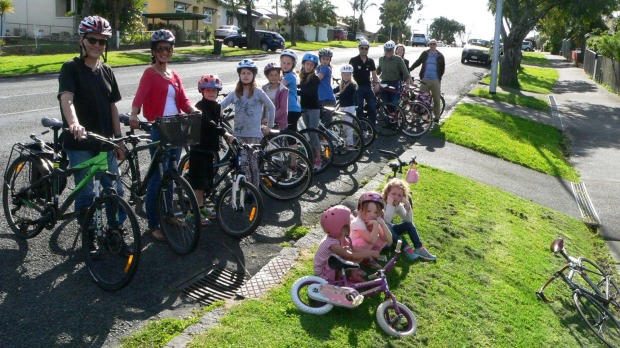
In 2017, AT chose the option that installed a bike path along the wide green berm on Old Mill and Garnet Roads, to maximally preserve on-street parking. Construction began – but soon ground to a halt, after being disrupted by objectors, including vandalising the work sites.
In 2018 the community called for AT to keep calm and carry on, with a joyful Bike to the Future rally coordinated by Generation Zero. This event drew hundreds of supporters, and AT’s new CEO showed up to express his ‘unwavering commitment’ to the projects.
AT regrouped and reset the project, with local surveys, bespoke fixes for the village shops, a community liaison group with diverse representatives, and a quality redesign commissioned from Boffa Miskell.
The outcome was significantly better than the original design, with greater attention to trees, pedestrian safety, parking, and other details beyond simple cycleways. We described it as ‘a gleaming example for communities all over the city’:
The biggest and best news is this is no longer (just) a ‘cycleway project’. It’s a total rethink of the vibe of our streets and our neighbourhoods. Inspired and powered by the vision of a place where it’s safe and pleasant for any kid or adult to ride a bike, this elevated design promises a positive outcome for every kind of person.
In mid November 2018, consultation began on this ‘beauty of a reboot’, with the aim of delivering it by 2021, within a second 3-year tranche of the Urban Cycleways Fund. We warmly encouraged you to “say ‘yes’ to beauty, and ‘yes’ to streets that help the youngest and the oldest to get around.”
Public feedback was voluminous, with over 1000 submissions and 70% support for the redesign. But before work could get properly underway in 2019, Covid put a spanner in the works.
During this whole period of design and redesign, Bike Grey Lynn – our local Bike Burb bunch – delivered tons of fun and encouragement on the ground, with bike to the market events, guided rides and e-bike adventures. And local heroes installed the famous pump track in Grey Lynn Park, attracting kids on bikes from miles around.

In 2021, AT completed the works in the West Lynn village shops, and in February 2022, engagement was refreshed to collect any further thoughts before construction began by Christmas 2022.
Six years after the first design was presented to the public, when will this project go to tender?
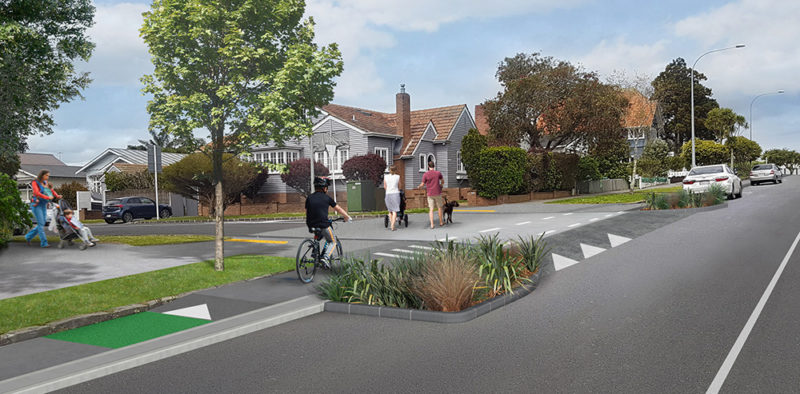
POINT CHEVALIER TO WESTMERE
March 2017 saw the first public consultation on a design for Point Chevalier to Westmere. At the time, we said:
The new bike lanes link two town centres and a couple of major sports fields – plus there are four schools and a kindy and a huge retirement village along the way. Like the Grey Lynn routes, this is a model for how major ‘backbone’ cycleways feed into neighborhoods and vice versa.
We put the plans into the context of the past and future of Auckland’s tram-suburbs, where ordinary people regularly walked and biked for transport, long before the invention of e-bikes. And we ran the numbers on what these routes would mean for the hundreds of daily bike trips already happening on the main roads (and, significantly, the footpaths thereof).
Public feedback on that early design was 2:1 in favour of protected bike lanes. There was some concern that the design sacrificed the pohutukawa street trees on the main road, and a general call for better design quality.
So, over the course of 2018, the design was further refined with input from a Community Liaison Group that included representatives from local schools, businesses, and the football club. One of the major updates was a plan to fold in a much-needed complete rebuild of Meola Road, from the foundations. Built on landfill, it’s showing its age under the weight of frequent buses and roughly 15,000 cars a day.
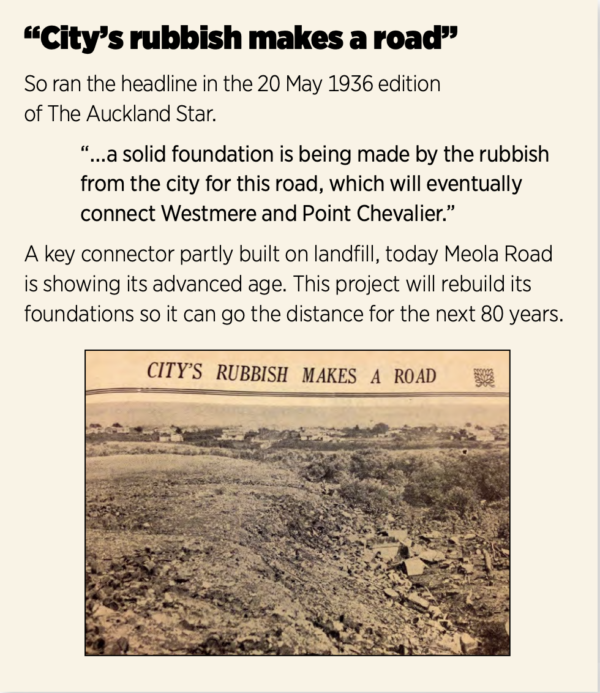
In 2019, a new and improved design was consulted on. We described it as ‘a great local example of Healthy Streets’ and offered seven great reasons to support the project. Public feedback on the updated design was strongly positive, 10:1 in favour of protected bike lanes and 5:1 in favour of pedestrian improvements.
Over the years of redesign, the neighbourhood – busy with locals on bikes, despite zero bike lanes to speak of – was home to many high-profile community initiatives, run for and by locals of all ages.
- The parent-led Pt Chev school bike train delivered small children en masse to school.
- Parents and children ran a neighbourhood-wide driveway safety campaign to raise awareness about the risks when kids have no choice but to bike on the footpath.
- Selwyn Village joined the international Cycling Without Age movement, bringing joy to elders
- Bike Pt Chev ran a bike-fix day, a try-a-bike day, and a highly successful Bike to Football programme for young soccer players that took dozens of cars off Meola Road on winter weekends
- Local groups coordinated a day-long community play street at the end of 2019
Everything paused in 2020 – except locals on bikes. Our Backyard Bike Count put Pt Chev at the top of the chart (second only to Tamaki Drive) when it came to local cycling on Level 4’s quiet streets.
In late 2021, AT installed a trial roundabout at the intersection of Pt Chevalier Road/ Meola Road, as a potential change to the consulted design, with positive reviews from local drivers.
In May 2022, AT informed the community via an area-wide mail drop that work would be getting underway in late 2022. This started with the felling of 34 mature trees on Meola Road to facilitate the undergrounding of overhead wires and moving of kerbs, in order to deliver the promised design.

As of November 2022, those trees have all been felled – and the project has yet to go to tender.
Nearly six years since the design was first brought to the public, when will work begin?

WHO PAYS FOR THE DELAY?
That’s a trick question. We all do.
It’s astonishing to think that the government co-investment has been locked in and waiting all this time – and has blown through two 3-year funding periods, and is now well into a third. It shouldn’t take a decade to deliver three connected projects.
It’s impressive that AT has leveraged this funding (and worked closely with communities) to elevate the original designs. Now fully future-proofed ‘dig once’ projects, they’ll deliver so much more than simple cycleways – improvements for public transport, walking, greenery, vital infrastructure repairs, and more.
So it is absolutely flummoxing that there are still no shovels in the ground for this great swathe of the network; and that a combined 18 years of planning and engagement and design has yet to materialise in solid form.
While we all wait for these three exemplary projects to get underway, communities all over the city are also waiting for good, swift action. And there’s more government investment on the way for rapid climate-responsive street changes – but how will that funding benefit Aucklanders, if AT and Council get stuck with a bad case of bike-lane block?
It’s not just that we’re in a climate emergency. It’s that we can already see the future all around us. Bikes, e-bikes and e-scooters are flying off the shelves and onto the streets as Aucklanders seek smart, fun, healthy and affordable alternatives to sitting in traffic. And our children need constructive hope.
The clock is ticking and it’s getting louder, telling us to move faster. We say to AT and Council: time to get the ball rolling on these projects – and let’s crack on with the rest as well.

We encourage you to write to the Auckland Council and Waitematā or Albert-Eden Local Board to express your support for these projects. Find tips in this handy guide.

